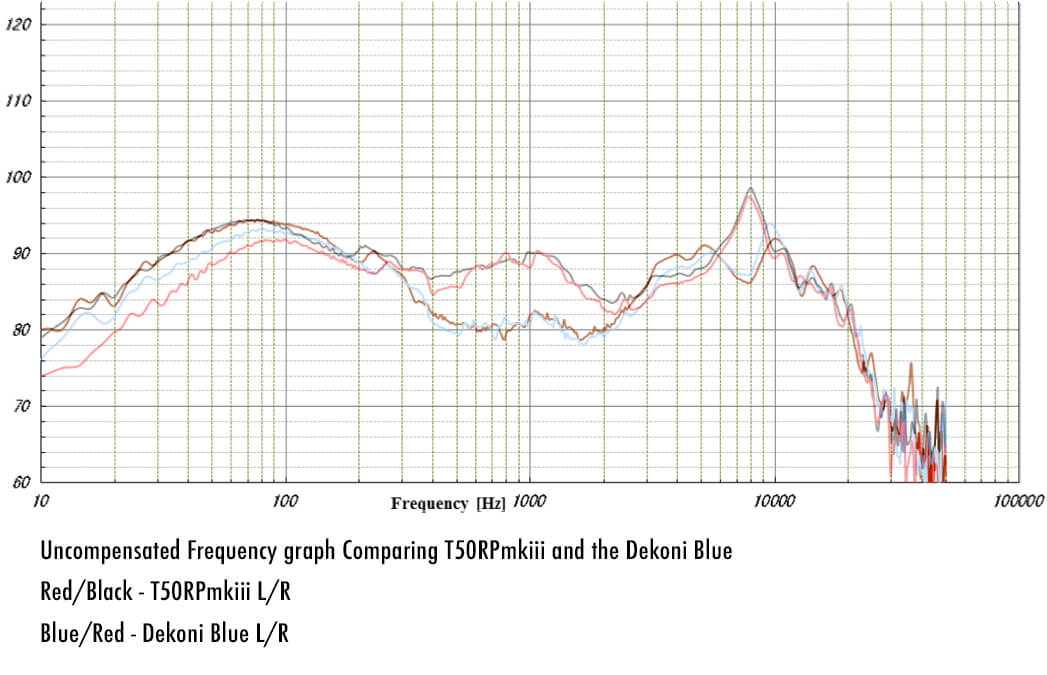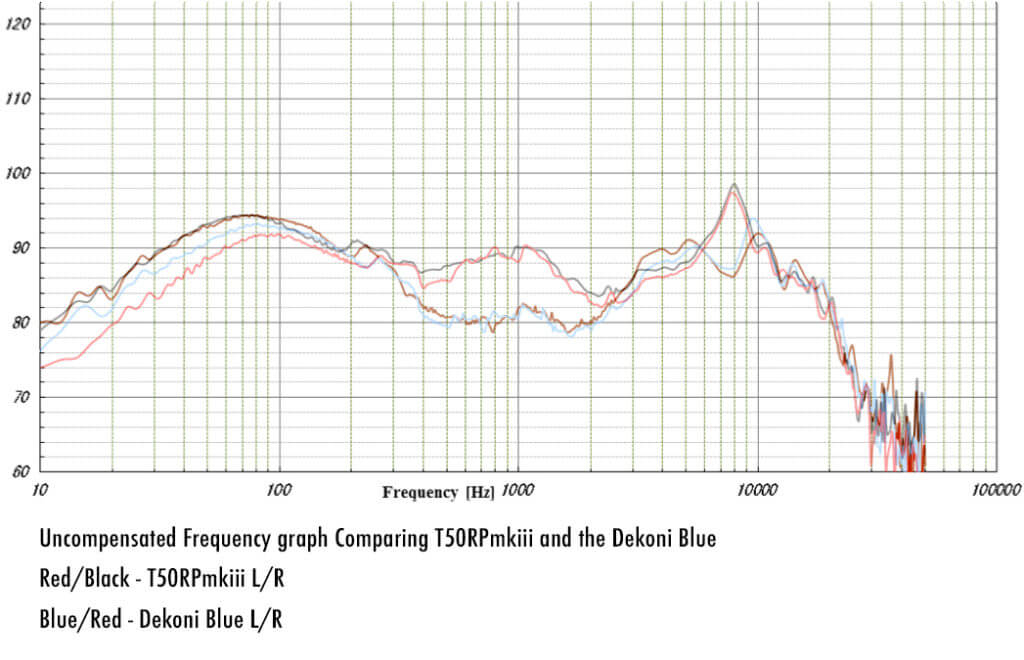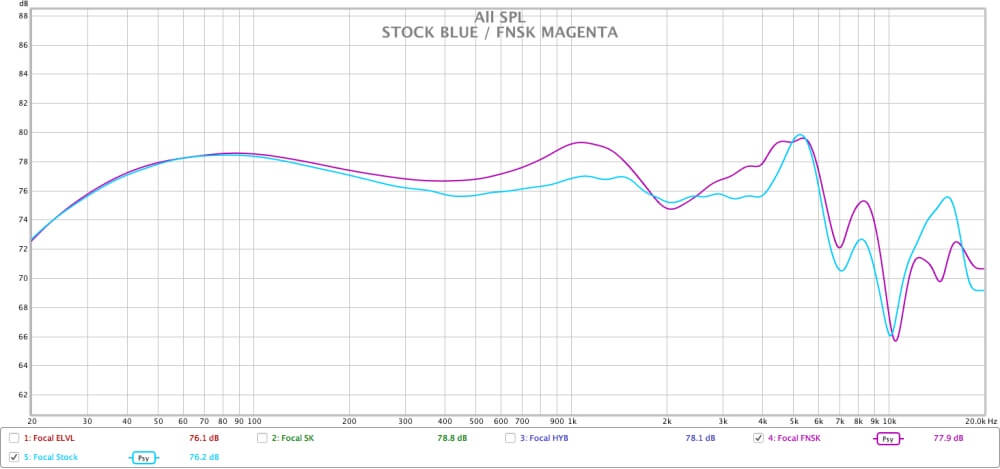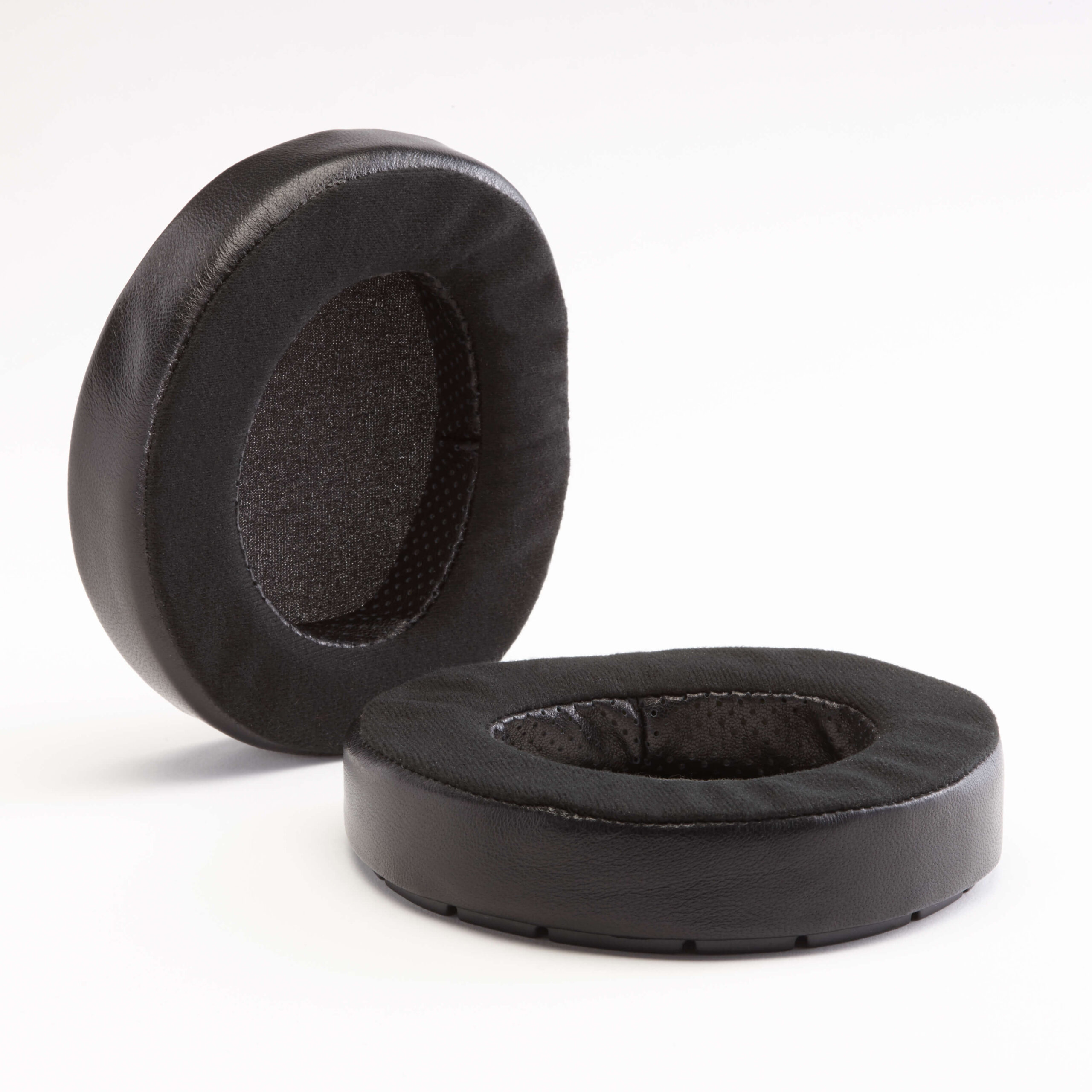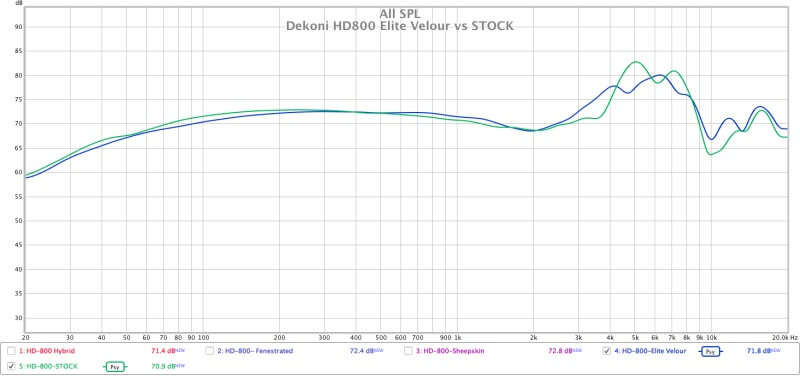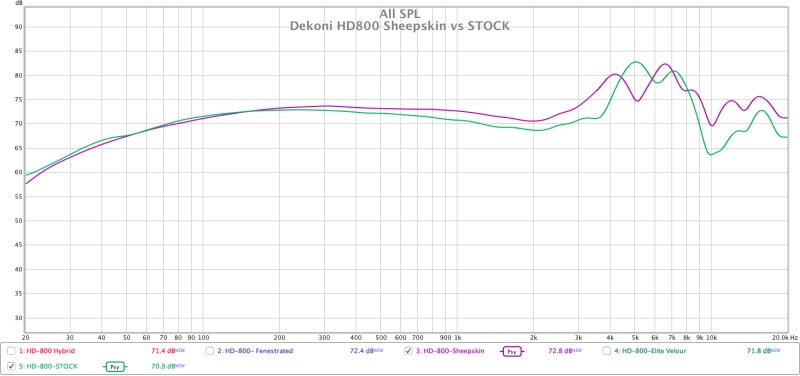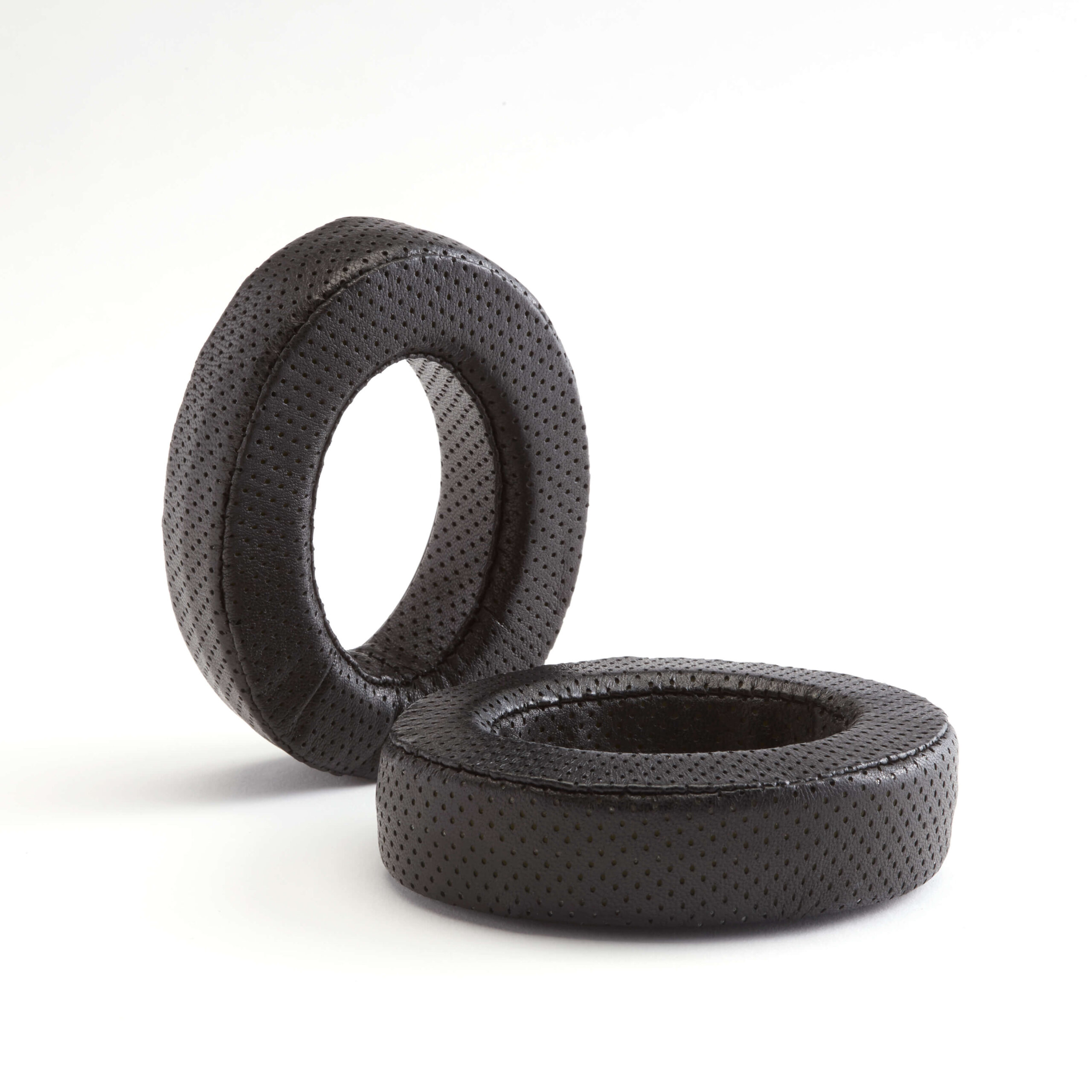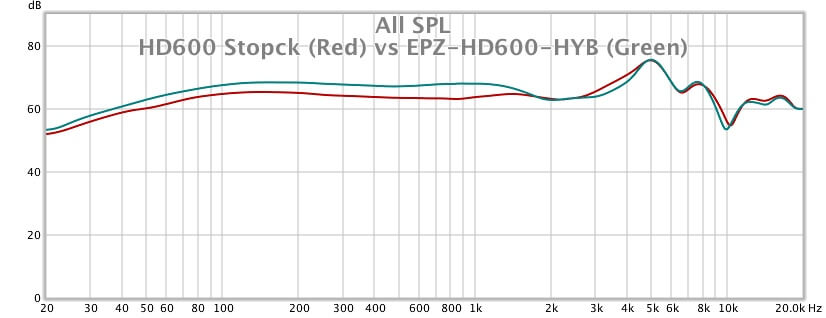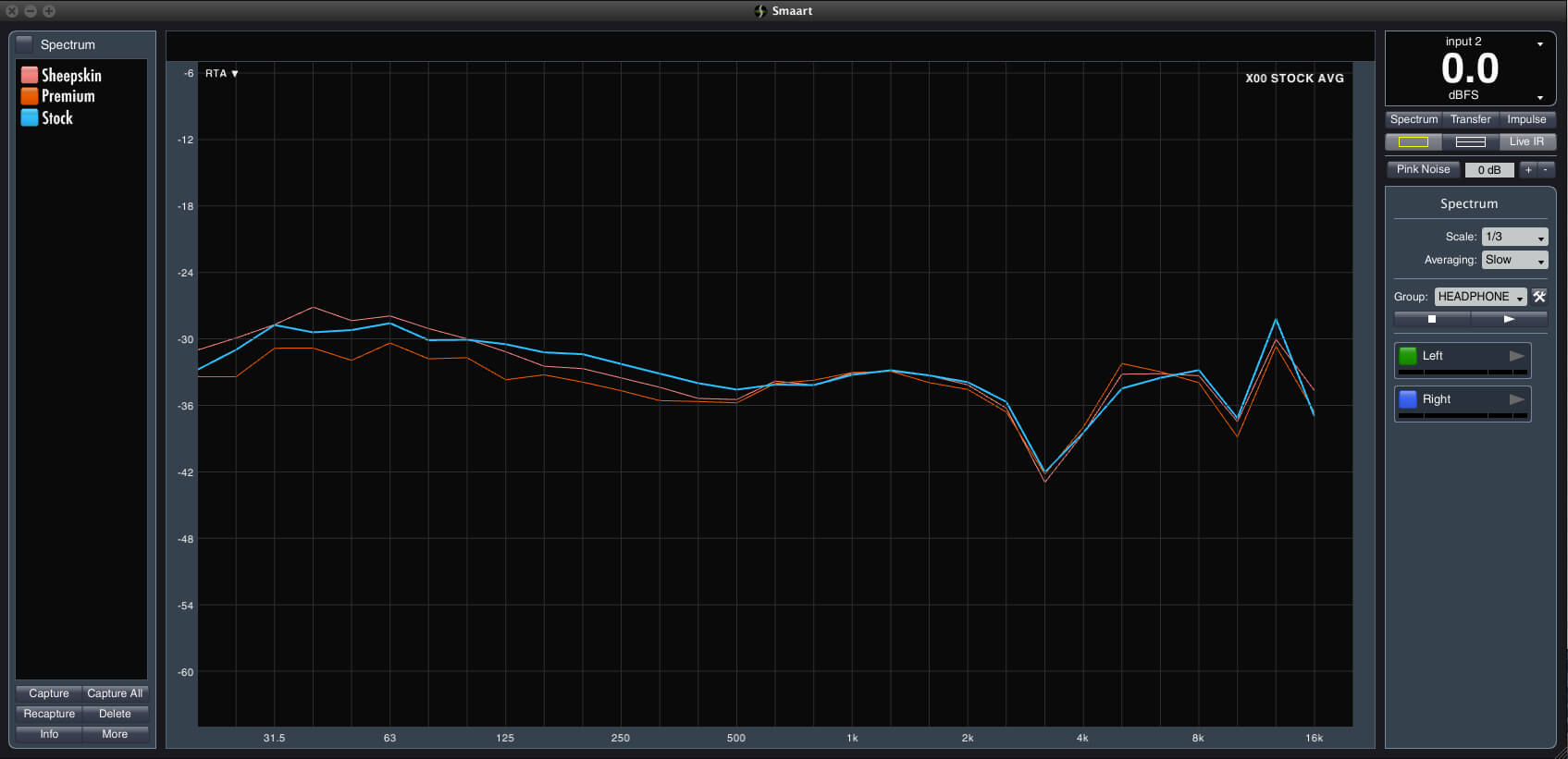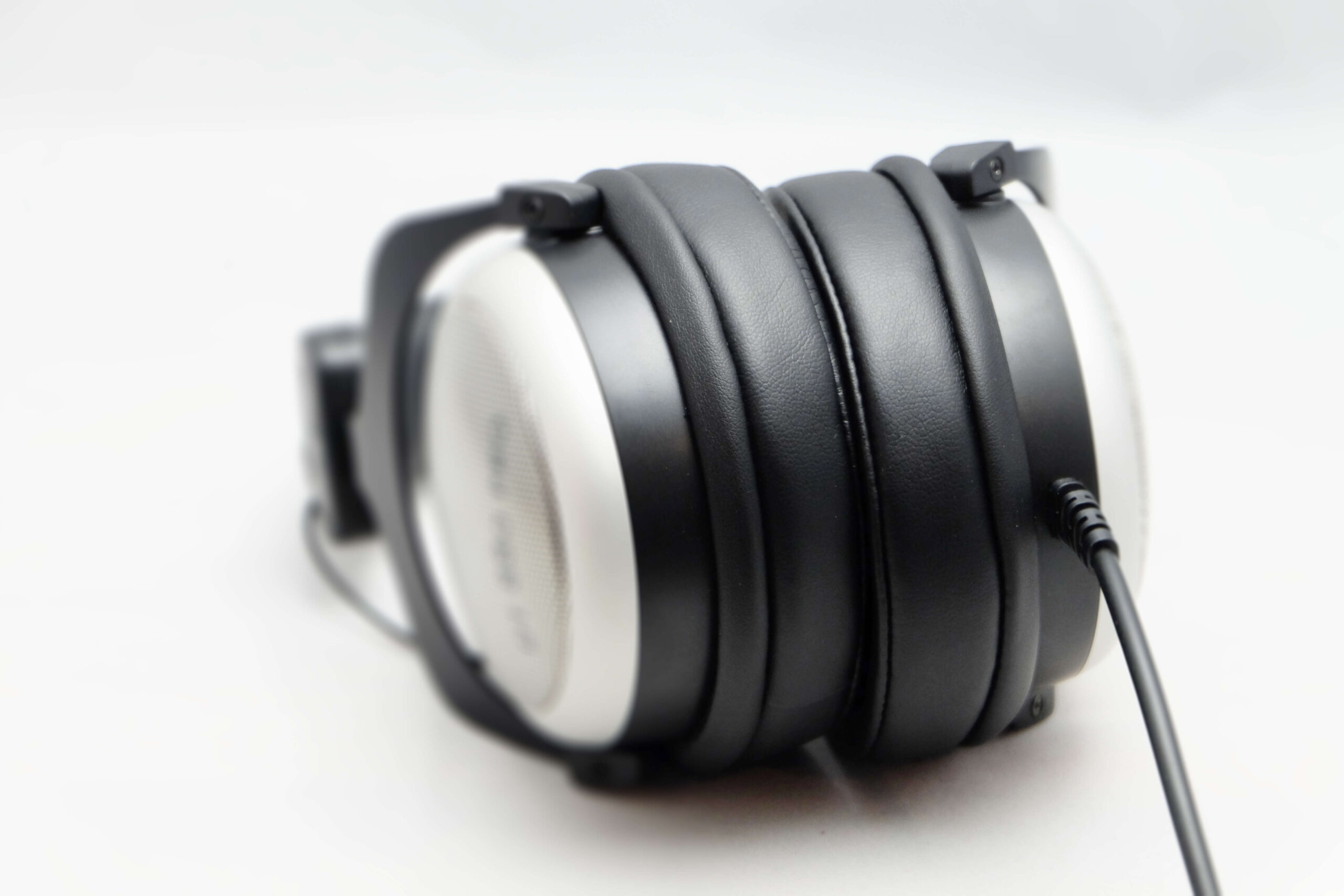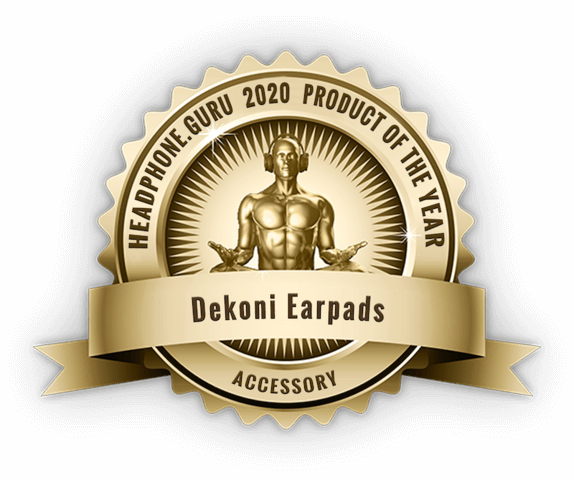- Home
- About
- Products
- Supported Brands
- Dealers
- Dekoni Gaming
- Blog
- Contact
- Home
- About
- Products
- Supported Brands
- Dealers
- Dekoni Gaming
- Blog
- Contact
Can't find your headphones? Contact us.
Author Archive
So people have been speculating on the Dekoni Blue and what we did to the Stock headphone to make Fostex take notice and agree to make it for us. We’re the only company who Fostex has agreed to produce a modified T50RP MKiii for and I think that says a lot. It is said that they made the MK3 because of the overwhelming demand for the modded MK2 over stock. Instead of realizing that people just like to make things their own and tinker, I think they took it as their headphone not being good enough. I think the MK2 became the perfect platform to play with but they saw it as a flawed product that people had to change to make better.
Anyway, They took a look at all the mods out there and essentially made their own and called it the MK3. Think about it. The padded headband, the venting under the pads on the front end of the cups, etc. The whole sonic signature. To my ears though, and to many others in the audiophile community, the MK3 wasn’t a very fun headphone to listen to. It’s very clinical and not easy to listen to for long periods.
The biggest issue I had with it was it had a large, odd, peak at 8Khz as you can see in the graph below. FYI, the graph was produced by Fostex so I’m not going to question it’s accuracy though I will say it is uncompensated for the human ear and is shown “flat.”
While I won’t go into detail about the specific changes within the headphone components we made I will say the addition of the asymmetrical ear pads we made for this headphone were designed in such a way to obscure the outer edges of the driver which, in turn, caused the “fatigue peak” to go away. My thought on the planar driver is that the way it is housed causes high frequency build-up in the corners and edges. By Obscuring the outer edges you smooth off that peak. That went a long way to helping me in my quest for a better T50RPmkiii.
The other changes I made were in the low end. I made some inner changes that allowed for a slightly extended bass response. I also was able to manipulate the driver output in such a way as to carve out some mids in order to bring out some more clarity and detail while making this a fun headphone to listen to. Unfortunately, you still need a headphone amp to drive these things sufficiently! That’s one issue I couldn’t find an internal modification for.
My goal in this project was to make the MK3 a fun headphone to listen to and I think I did that. It’s a little more V-shaped than the stock, has a little more oomph, and isn’t so brittle. I ask that you give the Dekoni Blue a chance as many of the folks that have listened to it at CanJam, RMAF, and the other shows around the world we’ve displayed them at have said this is the best sounding Mod yet for the MKiii that’s been produced and it’s a project I’m happy with and proud of. I have not created the perfect headphone nor have I claimed to and this might have just been a one off personal piece had Fostex not taken notice and made an offer to us. We are honored to have Fostex create this for us, our first venture outside of ear pads, and hopefully the first of many new products Dekoni Audio will be sending your way in the next 100 years (hopefully).
Want a pair for yourself? You can pick them up right here at dekoniaudio.com!
OK Dekoni Fans, Here’s the latest frequency graph of the all-new FOCAL ear pads we just released. I have these tested on an Elear headphone, just so you know. You’ll notice, right off the bat, the differences are all very subtle for the most part as you can see from the below graph showing all the 4 variants we make PLUS the stock. The biggest change comes in the higher registers which I’ll get to shortly.
First up is the Stock pad vs the Dekoni ELVL. These 2 are very close in frequency response up to 1khz and then you see a very slight rise in the 1.5 Khz territory and a 2db rise in the 8Khz range. Notice also a slight offset of the 5khz peak to the lower end at around 4.5khz. Finally, the ELVL pad seems to take a bit off the top peak that might make the headphone sound darker and a little more closed, depending on what you are listening to. I like this pad a lot with my Elears. They are a super comfy fit and I can wear them a long time without any fatigue.
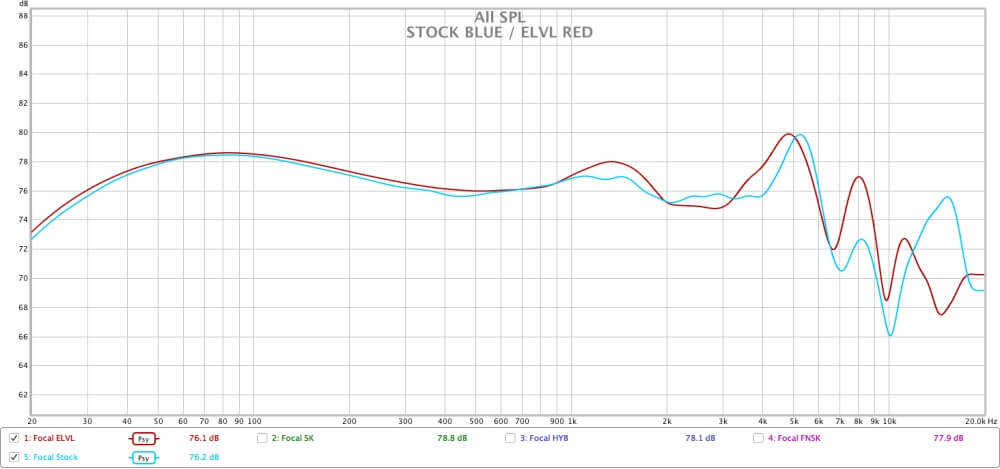 Coming in next is the Dekoni Audio Hybrid Ear Pad. The hybrid pad has Sheepskin on the outside, Velour on the Face of the pad, and fenestrated Sheepskin on the inside. As the inside “room” – the inner wall- of this pad is not the thin alcantra of the stock it is going to natural not absorb as much material so there’s a +1db rise in the overall level from this model. This leads to a more balanced sound when you look at the graph up until about 10khz where we get a dip in the high frequencies that formed a pretty large peak in the stock pad combo. I liken this to taking a bit of the air off the top and is fairly subtle for most material that has been close miced. You may notice more of a difference if you are listening to classical or something with a lot of room sound.
Coming in next is the Dekoni Audio Hybrid Ear Pad. The hybrid pad has Sheepskin on the outside, Velour on the Face of the pad, and fenestrated Sheepskin on the inside. As the inside “room” – the inner wall- of this pad is not the thin alcantra of the stock it is going to natural not absorb as much material so there’s a +1db rise in the overall level from this model. This leads to a more balanced sound when you look at the graph up until about 10khz where we get a dip in the high frequencies that formed a pretty large peak in the stock pad combo. I liken this to taking a bit of the air off the top and is fairly subtle for most material that has been close miced. You may notice more of a difference if you are listening to classical or something with a lot of room sound.
The Sheepskin variant is one that is very close to stock in a lot of respects but also ads some overall level to the headphone at about +1db. It maintains the air on the top of this headphone and maintains that stretching down to about 8khz. A little added body between 600hz to 1000hz rounds out this model as a nice addition to the headphone. It manages to warm it up while maintaining the open sound this headphone is known for.
Below we have the Fenestrated Sheepskin model. This is the one everyone has been asking for as they love the pads Focal makes for the Utopia on the Elear. I think I prefer this pad as well for the Elear as it creates a smoother transition throughout and little more presence overall. The low end engagement is very similar to stock with a rise coming up on 1Khz and a smoother rise into 5Khz than stock. You’ll just have to see for yourself!
That does it for this edition of “What-the-hell-are-these-pads-going-to-do-to-my-headphones” for today. I think we made another great ear pad for the the Focal Line up in comfort and sound. I try to do these so we can get away from a lot of the subjective-ness that rules us though everyone will always hear things differently so one’s opinion is not to be discounted. I think this gives a good baseline for the Ear pad and I can’t wait to hear what others think about it as well!
As always, I can be reached at tal@dekoniaudio.com if you want to ask some questions or badger me about whatever’s on your mind!
-Tal Kocen
So here we are again everyone. It’s time to inspect the Dekoni Audio HD800 Ear Pads and see where they lie in the “spectrum” of things. This is a pad we’ve been working on for a long time and I’m personally proud of the way they sound and the way they feel. The first thing I will say is that the Sennheiser HD800 has a peak at around 5khz that has always bugged me. It seemed out of place and when listening to certain songs it makes things stick out like a sore thumb! In designing this pad, one thing I have tried to do was to smooth out that peak and by testing with different baffling materials, we’ve managed to do just that.
Now, the Sennheiser HD800, that we all know and love, is a VERY open headphone with a massive driver. That said, when the pads are swapped the differences aren’t nearly as stark as they would be with a closed back headphone. They are, for the most part, very subtle. The biggest difference, IMHO, is that while they don’t necessarily change the frequency response much, they move the drivers away from the ear and create more space within the headphone. This has the effect of opening the sound stage and widening the image while also creating more depth. In fact, an employee of Sennheiser who has listened to this ear pad on their headphone even said that he felt our pads made the headphone sound better!
Let’s move on to the frequency analysis, shall we? First up is the Hybrid pad. As you can see in the image below there is VERY LITTLE difference in the sound signature all the up to about 2khz. You will also notice a smoother transition out of the “conchal bowl” and a nice arch over the peak while maintaining a little more of the higher 10khz+ material which, to my ear, adds some air and a hint of sparkle to the sound.
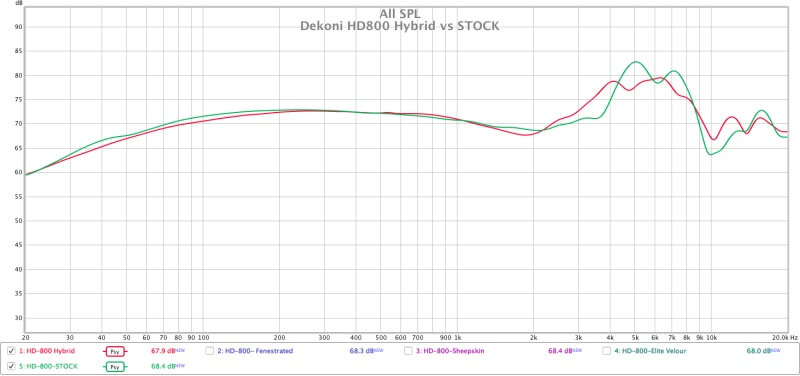 Next up is the Fenestrated Sheepskin. The frequency response on this one is almost identical to the Hybrid Pad. That is because the hybrid pad uses the same fenestrated Sheepskin on the inside of the pad. The main difference between the two is comfort. Do you like Sheepskin on your face or do you like Velour? I have a beard and sometimes the velour can get caught and pull. It’s mostly personal preference though. Let’s move on….
Next up is the Fenestrated Sheepskin. The frequency response on this one is almost identical to the Hybrid Pad. That is because the hybrid pad uses the same fenestrated Sheepskin on the inside of the pad. The main difference between the two is comfort. Do you like Sheepskin on your face or do you like Velour? I have a beard and sometimes the velour can get caught and pull. It’s mostly personal preference though. Let’s move on….
 Now let’s have a look at the Elite Velour pad for the Sennheiser HD800 Headphone. This one is super cozy and also looks remarkably similar to the other 2 above. As I stated before, the ear pads don’t make as much of a frequency signature change as they would if you were to put them on closed back headphones. The biggest difference here is the Elite velour pad will absorb a little more of the high frequency material and so you see an ~3db dip between 10khz and about 14khz. It seems to take away some of the sparkle but causes the overall warmth to get accentuated a bit. Again, though, we see that 5khz peak diminished and the high frequency material smoothed out. Diana Krall’s Temptation sounds amazing here!
Now let’s have a look at the Elite Velour pad for the Sennheiser HD800 Headphone. This one is super cozy and also looks remarkably similar to the other 2 above. As I stated before, the ear pads don’t make as much of a frequency signature change as they would if you were to put them on closed back headphones. The biggest difference here is the Elite velour pad will absorb a little more of the high frequency material and so you see an ~3db dip between 10khz and about 14khz. It seems to take away some of the sparkle but causes the overall warmth to get accentuated a bit. Again, though, we see that 5khz peak diminished and the high frequency material smoothed out. Diana Krall’s Temptation sounds amazing here!
Finally, we have the Dekoni Audio HD800 Sheepskin ear pad for the Sennheiser HD800 Headphone. This one is probably the one that makes the most sonic difference as the Sheepskin material by nature is thicker and less porous than the others. By “the most difference” I need to point out that the change is still subtle. What this means is that the sheepskin does NOT absorb much of the material that hits it. I like to call them sonic funnels! It just keeps the material moving on through to your ear. Starting at around 200hz you can see the frequency graphs start to diverge. It creates an even smoother run-up to about 4khz before it dips slightly and then maintains the high frequency material. Here you can really see the difference a smooth shiny surface does in comparison to a dull, porous one. The high frequencies don’t get absorbed at all and you maintain more material and “air” to what you’re listening to. This pad is great for a little extra lit in the top end. Great for Classical listening. Try it out on Claude Debussy’s “la Mer.” Debussy’s use of the French horn really shines here!
That’s it for the Dekoni ear pads for the HD800 from Sennheiser. Thanks for reading and I hope this can better inform your decision about which pads are right for you. As always, I’ll say you should buy them all, but I would say that- I own the company! If you want to comment or just chat about life feel free to reach out to me.
My email is tal@dekoniaudio.com and I live online.
Want a pair for yourself? You can find them through our domestic or international dealers, or directly from us through the following links:
Ok, here it is. The long-awaited Frequency Comparison charts for the Dekoni Audio HD600 Ear pads. Careful analysis and hours of listening go into our ear pads and we stand by our models as the best of the best as far as replacement ear pads go. I’m going to just jump right into it.
I will say, before I continue, that you should always give new pads a few days of listening to get used to them before issuing any judgements for or against. A pad swap is probably the quickest and most effectual mod you can do to a set of headphones so the difference you hear may be very different from the pads you previously had on the headphones. That said, sometimes one may equate sounding “different” with sounding “worse” because it’s not the same (which they grew to like and love). Given a chance though you may find the new pads, once you adjust, actually make a change for the better that you didn’t think was coming. So always give pads a chance. You Just might find they’re better than the ones you had and that’s what we do this for.
Also, note that because the Headphones are open back the sound will not change as much as they might with, say, a closed back set as you aren’t changing the inside pressure levels or air flow nearly as much. You will see that the graphs on the 4 variants are very similar with a few minor differences. No change is greater than 2-3db between any of the frequencies so everything is fairly subtle. Nothing drastic happening.
First up is the most popular pad in the line-up. The HD600 Fenestrated Sheepskin. You will see from the image below there is a fairly equal lifting of the frequency range from the bottom to about 2,000 cycles. This is representative of the change from a rounded pad to a Squared off one where the inner wall of the pad acts more as a funnel in rather than a diffusor as a rounded pad might. You will notice this in all the variants and they are all very similar in their response. The lower frequencies have nowhere to go but inside your ear. You’ll notice a slight dip then between 2K and 5K on the Fenestrated pad with the frequency response remaining almost identical up to 20K with a slight bump on stock above 15K. All of this goes to the Dekoni pad, to my ears, sounding a little warmer. I have felt the HD600 to be missing a little “meat’ in the mid-range and our pads seem to bring it in just enough. 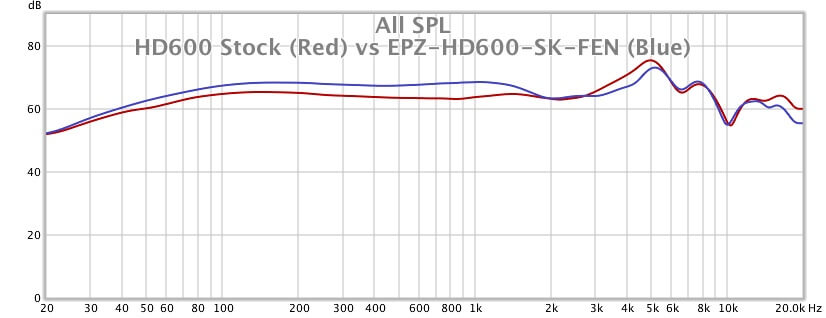
Next up is the Dekoni Sheepskin Edition. You’ll notice it looks very similar to the Fenestrated all the way up to about 12.5K where there is a significant amount of the high frequency material that is maintained, instead of lost to the stock Velour pads. To my ears, this pad cuts the frequencies in the “conchal bowl” enough that they sound more neutral in this configuration. Instead of seeing a boost in the low and boost in the high, picture if you increased the amplitude of the Sheepskin pad graph and it would invert to a slight dip between 3K and 10K, where our ears are most sensitive. This is due, again, to the sheepskin surface directing all the frequency material from the speakers into your ears instead of the loss you experience into the pads.
The Hybrid pad is very similar to the others in the sub 2K range but above that it is almost an exact frequency match with the Stock pads. These sound a little louder than stock (less material loss) with a slight screen on the high end which seems to even out the tone of the headphones.
Now, on to the Elite Velour model which matches very similarly to the Fenestrated Sheepskin as well with not quite as much of a rise above the 2K Range but some is still present. These pads are extremely comfortable and seem to maintain a lot of the Primary characteristics of the HD600.
That Folks, is one opinion of many but it is mine and I’ll stand by it! Thanks for reading an I hope that we have made a pad for the HD600 that people will see as an upgrade and an update to the stock pads. If you want to discuss further please feel free to reach out to me personally at the email here.
Tal Kocen
Owner, Dekoni Audio
Want a pair for yourself? You can find them through our domestic and international dealers, or at dekoniaudio.com through the following links:
So here we are in the middle of another run of the X00 Pad from us, Dekoni Audio on Massdrop https://www.massdrop.com/buy/dekoni-premium-earpads-for-fostex-th-x00. I wanted to personally reach out again and Show some frequency graphs of some comparing I did. I’ve been testing and tweaking as we design in our lab and we have some really great things coming. I wanted to show the sonic differences in between the options here as they appear in an objective (as close as we can get anyway) testing scenario. We have designed a special testing “head” mic that is designed to mimic the human head and auditory system as closely as we can. It’s not perfect but for the purpose of comparing it works fantastically. We run Pink noise though the headphones and use specially calibrated microphones on each side of the head mic to gather the data. For those of you that do not know what Pink noise is, it is every frequency from 20-20,000HZ (the human hearing range) played at the same time and at the same volume, or amplitude. What this allows us to do with specially designed software is measure each and every frequency and how the headphones play the sound. Headphones don’t play all frequencies at the same volume and this is due to a variety of factors I won’t get into here. The graphs below all show the X and Y axis. The X axis is the frequency range from 20hz-20,000HZ and the Y axis is amplitude, or volume. So the “higher” the graph along the frequency range, the “louder” that frequency was in the testing. Also note that for every 6db in Sound pressure level increase/or decrease, you are effectively doubling, or cutting in half-depending on which way it goes, the volume. for example, 85dB is twice as loud as 79dB and only half as loud as 91dB. SO now off to the graphs. FYI, All ear pads were tested with the test material at the same level so as to provide accurate comparison.
The first one here is all the iterations of the X00 pad. You’ll notice the biggest differences come in the lower frequencies (below 500hz). From the testing I did it seems that the attenuation ring does bring the low end up a decent amount though no increase is more than 3db (which is half the volume). There is also a boost, however slight, in the upper registers too whoch contributes to the clarity of the headphone. The pad that tested closest to stock is the Sheepskin with no ring but there is a fairly noticeable dip around the 500hz-1khz octave that may attribute to people saying they like the mid-range better on the Dekoni Pads. Those frequencies are the “nasal” frequencies and they can be harsh to some.
 The Graph ABOVE Shows the Stock pad vs the Sheepskin Pad with the attenuation ring. In the sub-bass frequencies (where the headphone sounds nice as it is) you find a pretty good bump and that helps bring those sub frequencies out which, IMHO, really makes the headphone shine. There is also a bit of brightness and clarity that comes with the Sheepskin pad with the ring that you don’t get with the stock pad.
The Graph ABOVE Shows the Stock pad vs the Sheepskin Pad with the attenuation ring. In the sub-bass frequencies (where the headphone sounds nice as it is) you find a pretty good bump and that helps bring those sub frequencies out which, IMHO, really makes the headphone shine. There is also a bit of brightness and clarity that comes with the Sheepskin pad with the ring that you don’t get with the stock pad.
 Next up is the Sheepskin pad with the ring and without. It’s a very similar response as with the above measurement. The bass is given a small boost as are the higher frequencies. Again, it’s all very slight but noticeable to some people and not so much to others.
Next up is the Sheepskin pad with the ring and without. It’s a very similar response as with the above measurement. The bass is given a small boost as are the higher frequencies. Again, it’s all very slight but noticeable to some people and not so much to others.
 Down below 500hz, where most of the change in the sonic signature between the pads originates, is highlighted below. You can see that each pad is fairly consistent in it’s amplitude difference compared to the others which I found to be interesting. Again, the addition of the Attenuation ring seems to funnel the low frequencies somewhat and bring them to the fore.
Down below 500hz, where most of the change in the sonic signature between the pads originates, is highlighted below. You can see that each pad is fairly consistent in it’s amplitude difference compared to the others which I found to be interesting. Again, the addition of the Attenuation ring seems to funnel the low frequencies somewhat and bring them to the fore.
 The Final Graph in this series is one that highlights the differences between the ear pad configurations above 2khz. Around 2.5Khz we have a convergence where they all show roughly the same response and then the attenuation ring containing configuration become more dominant again. I’ll note the difference looks large but between the upper and lower lines the difference is only about 2db. It’s just enough I think to bring a little shine out of the headphones as others have said.
The Final Graph in this series is one that highlights the differences between the ear pad configurations above 2khz. Around 2.5Khz we have a convergence where they all show roughly the same response and then the attenuation ring containing configuration become more dominant again. I’ll note the difference looks large but between the upper and lower lines the difference is only about 2db. It’s just enough I think to bring a little shine out of the headphones as others have said.
That is all for now. I see that people are interested in the TH900 pad and how it works with the Fostex X00. I can run the comparisons on those too. To my ears, the TH900 Sheepskin pad we sell opens the headphones up quite a lot. It’s definitely different- and when there’s a difference, some people will like it and some won’t. one thing I always keep in the back of my head is that ALL of this is subjective to what you’re listening to. Our tests are run with pink noise but no one in their right mind listens to pink noise so with other material that are heavier in certain ranges the different pads might have the headphones reacting in a different manner. It all depends. I just thought the community would like to see some evidence and then judge for themselves. If anyone has any further questions or comments feel free to hit me up.
So I did a comparison of the frequency response of the Fostex X00 Headphone between the different pads available from us on Massdrop.com. Stock for reference vs the Sheepskin and the Premium Protein Leather. If you look you will see they are very close in db going up from about 500hz. The horizontal lines equal 6db and every 6db you go up or down the “volume” is doubled and it’s exponential. 86db is twice as loud as 80db. 3db up or down is half the volume and is about the limit of most people’s abilities to discern a difference. so you can see that between the stock and Sheepskin there is a slight boost (maybe 3db) in the sub-bass but a very slight decrease between 125hz and 500hz. Maybe 2db along that range. To my ears the sheepskin carves out a small amount of the low mids (which, for me, amount to the “muddy” frequencies) and the highs remain mostly consistent with a slight boost which the graph says is around 5khz. I like the effect of the Sheepskin. The large cut around 3-4khz is common to most headphones as the manufacturers are compensating for our own ear design and the resonance of our conchal bowl. Humans evolved a boost around those frequencies to help us listen and react to danger. By creating a dip there the headphones should sound more “flat” in that range. The high end boost around 13khz I am assuming is to create a little “air” and space in the listening experience.
My Subjective opinion on frequency response and adjusting the changes
In trying new pads on headphones (or headphones in general) you always need to give your hearing some time to adjust. I know with my ears I get complacent listening to a certain frequency curve and if it changes it can be a startling thing and I instantly go to the negative in describing it because it is different. Upon letting myself adjust it may turn out I like the change. Maybe the frequency response change actually brings parts of the music out I didn’t know were there. You may swap pads and because the new ones take some bass out of the headphone they might sound bright to you but if you allow time for your ears to adjust them you just might find you actually like the change better. It’s all subjective so I always take other’s comments with a grain of salt. I personally like a more flat, even toned listening experience (I’m an audio engineer by trade) but the next guy might like a great pumping bass. When you replace your pads just try to enjoy them as they are and not as the pad they are replacing. I always say….identify and don’t compare.
Ear pads are the difference between comfortable and un-comfortable headphones. They can make or break a decision and trump other merits such as sound quality and brand preference. Dekoni Audio Ear Pads are made to be the most comfortable ear pads available and the use of quality protein leather and memory foam we feel our…
For me, earpads are the first thing I think of in the morning! Replacement earpads are something I’ve been interested in ear pads since i smelled my first pair of headphones after a few months on the road. I won’t name any names but the pads started to disintegrate and the odor was getting funky. I…
Recent Posts
- Samsung Galaxy Buds2 Pro Replacement Memory Foam Eartips | Dekoni Bulletz
- Dekoni x Hifiman Cobalt | Achieve Your Desired Sound With The New Dekoni x Hifiman Cobalt Foam Baffle
- New Earpads for the AudioQuest Nighthawk Headphones
- AudioQuest Nighthawk | Dekoni Audio Replacement Earpad Measurements
- New Earpads for the Meze Audio Liric Headphones
- Meze Audio Liric | Dekoni Audio Replacement Earpad Measurements
- New Ear Pads for the Beyerdynamic DT700 & 900 Pro X Headphones!
- Beyerdynamic DT700 & 900 Pro X | Dekoni Audio Replacement Earpad Measurements

You were not leaving your cart just like that, right?
Enter your details below to save your shopping cart for later. And, who knows, maybe we will even send you a sweet discount code :)
Order Locally!
Would you like to shop from your country, or continue to DekoniAudio.com for product information?



